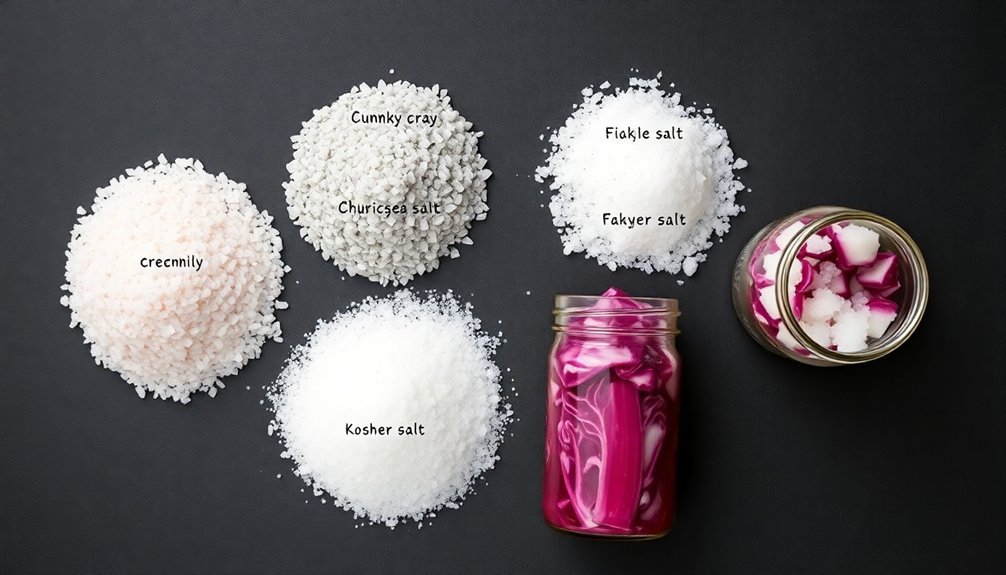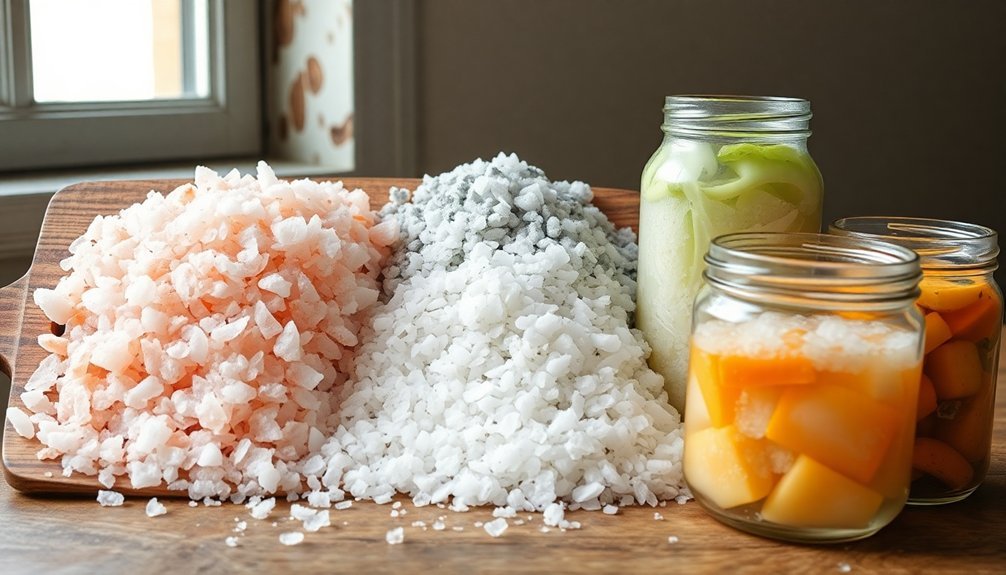You'll find five reliable salt options for fermenting vegetables: pickling salt, sea salt, kosher salt, Himalayan salt, and pure refined salt. Each type offers unique benefits for successful fermentation. Pickling salt dissolves easily and won't cloud your brine. Sea salt adds beneficial minerals and creates ideal fermentation conditions. Kosher salt's coarse texture makes measuring precise and consistent. Himalayan salt provides subtle flavor and essential minerals. Pure refined salt works well for basic ferments. The key is choosing salt without anti-caking agents or iodine that could interfere with fermentation. Understanding each salt's properties will help you craft perfect ferments every time.
Why Salt Matters in Fermentation

From preserving crunchiness to controlling fermentation rates, salt plays several essential roles in the vegetable fermentation process. When you're fermenting vegetables, salt creates the perfect environment for beneficial bacteria to thrive while keeping harmful microorganisms at bay. It works by pulling water and sugars from your vegetables, creating a nutrient-rich brine that feeds the good bacteria. Clean salt without additives will produce the best fermentation results.
Salt's concentration directly affects how quickly your fermentation progresses. You'll find that lower concentrations of 1-2% lead to faster fermentation, while higher amounts of 3-10% slow things down. This control helps you achieve the exact texture and flavor you're looking for. The salt also strengthens plant pectins, ensuring your fermented vegetables maintain their satisfying crunch.
Beyond preservation, salt's vital role includes creating an anaerobic environment by keeping vegetables submerged in brine. This oxygen-free setting is essential for successful lacto-fermentation.
You'll need to adjust your salt levels based on what you're fermenting – sauerkraut works best at 2.25-2.5%, while pickles might need anywhere from 3-16%, depending on your recipe and preservation goals.
Pickling Salt for Traditional Results
Looking for the most traditional salt for fermentation? Pickling salt stands out as a highly refined option that's specifically designed for preserving vegetables. You'll find it's similar to table salt but without the iodine and anti-caking agents that can interfere with fermentation.
What makes pickling salt particularly effective is its fine texture, which dissolves quickly in water and creates an ideal brine solution. For optimal results, dissolve 1-3 tablespoons in 4 cups of water to create your brine. You can use it for both brining and dry salting techniques, typically in concentrations of 2% to 5% by weight. It's especially useful when fermenting vegetables that don't produce enough liquid on their own, like green beans or asparagus.
While pickling salt isn't as mineral-rich as sea salt or Himalayan varieties, its purity makes it perfect for traditional fermentation. You won't have to worry about additives disrupting the growth of beneficial bacteria or affecting the taste and texture of your fermented vegetables.
When you're aiming for consistent, reliable results, pickling salt helps maintain the crunch of your vegetables while enhancing their flavor through the fermentation process.
Sea Salt's Mineral-Rich Benefits

With its wealth of trace minerals and natural compounds, sea salt offers unique advantages for vegetable fermentation. When you're using mineral-rich varieties like Celtic sea salt, you'll benefit from their unrefined nature and lack of additives that could interfere with the fermentation process.
These salts create an ideal brine that draws moisture from vegetables while maintaining the perfect anaerobic environment for beneficial bacteria to thrive. The natural preservative effect of sea salt helps extend the shelf life of your fermented vegetables.
You'll find that sea salt's natural mineral content enhances both the fermentation process and the nutritional value of your final product. At a recommended concentration of 2-5% by weight, it effectively controls harmful microorganisms while promoting the growth of beneficial lactic acid bacteria.
- Crystal-clear brine forming around crisp cabbage leaves as salt draws out their natural moisture
- Tiny bubbles rising to the surface as fermentation actively progresses
- Vibrant colors of vegetables staying bright and fresh in the mineral-rich brine
- Crunchy texture maintained through the careful balance of salt concentration
- Natural gray or off-white crystals dissolving smoothly into your fermentation vessel
Remember to avoid over-salting, as this can inhibit beneficial bacterial activity and affect the final taste of your fermented vegetables.
Kosher Salt's Versatile Properties
Kosher salt's crystal-clear purity makes it a fermentation powerhouse for vegetable preservation.
You'll find its coarse, flakey texture perfect for precise measuring and even distribution throughout your ferments. Without iodine or significant anti-caking agents, it won't interfere with the beneficial bacteria essential to successful fermentation.
You can count on kosher salt's versatility in both brine and crush methods. For a standard brine, mix 2 tablespoons of kosher salt per 4 cups of water, or adjust the ratio to achieve your desired fermentation results.
Whether you're working with watery vegetables like cabbage or drier produce that needs a full brine, kosher salt dissolves quickly and maintains consistent salinity.
What makes kosher salt particularly attractive is its practical value. You'll find it readily available in most grocery stores at reasonable prices, and its pure sodium chloride composition guarantees reliable results every time.
If you're new to fermentation or an experienced fermenter, you can trust kosher salt's consistency. Just check the label to verify you're getting a product with minimal additives, and you'll have an excellent foundation for your fermentation projects.
Choosing Between Himalayan Salt Options

Selecting Himalayan salt for fermentation opens up a world of mineral-rich possibilities. When choosing between options, you'll want to focus on the salt's purity and mineral content. Unlike table salt, Himalayan salt doesn't contain additives that could interfere with the fermentation process, making it an excellent choice for your vegetable ferments.
Look for these distinct characteristics to ascertain you're getting quality Himalayan salt for your fermentation projects:
- Pure white to deep pink crystals that sparkle under light
- Coarse, irregular-shaped granules that dissolve evenly in brine
- Clean, mineral-rich aroma without any chemical smell
- Transparent or translucent appearance when held up to light
- Natural variations in color indicating mineral content
When using Himalayan salt in your ferments, you'll notice it dissolves readily while creating a perfect environment for beneficial bacteria. Its 2% concentration recommendation makes it easy to measure accurately for your recipes.
You can confidently use it interchangeably with other natural salts, though you might prefer its subtler, sweeter taste profile. For those monitoring sodium intake, you'll appreciate that it contains less sodium than traditional options while still delivering excellent fermentation results.
Frequently Asked Questions
Can I Mix Different Types of Salt During Fermentation?
Yes, you can mix different salt types during fermentation as long as they're additive-free. Just make sure you avoid iodized salt and maintain proper salt-to-water ratios for successful results.
How Long Does Fermenting Salt Last in Storage?
Your fermenting salt will last indefinitely if you keep it in an airtight container away from moisture. It won't spoil or expire, but you'll want to prevent clumping by storing it in a dry place.
Should Salt Be Added Before or After Crushing Vegetables?
You'll want to add salt before crushing your vegetables. This helps release water to create a natural brine, making it easier to pack them into your fermentation container for best results.
Does Salt Color Affect the Taste of Fermented Vegetables?
While salt's color itself won't affect your ferment's taste markedly, the minerals in colored salts (like pink Himalayan or gray Celtic) can add subtle flavor nuances to your fermented vegetables.
Can I Substitute Regular Salt With Salt Substitutes for Fermentation?
You shouldn't use salt substitutes for fermentation as they won't create the right environment for beneficial bacteria. Stick to pure salts like Himalayan, sea, or pickling salt for successful fermentation results.
In Summary
You'll find that any of these five salt varieties will serve you well in your fermentation journey. Remember to avoid iodized table salt, as it can inhibit fermentation and create off-flavors. Whether you're using pickling salt for traditional results, mineral-rich sea salt, versatile kosher salt, or pink Himalayan varieties, stick to pure, additive-free options. Start with small batches to perfect your technique and develop your salt preferences.





Leave a Reply